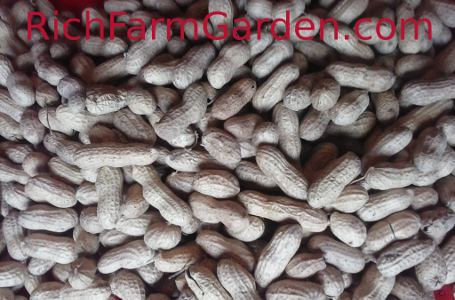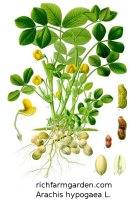Peanut
PEANUT
For planting instructions and seed specs, see Cultivation below

Rich's Indiana Peanut (90-100 days)
This variety has been developed to perform well in cooler
conditions. Plants are erect with yellow blooms and large
seeds. Better cool germination leads to earlier planting and
higher yields than Virginia Jumbo. Easier cleaning shells at harvest
make this a good variety for planting in richer and less sandy
ground.
| #12361 2oz in shell (Approximately
45 seeds) Packet $5.50 |
|
| #B1-12361 Bulk seed
1lb in shell $11.99 |
|
Virginia Jumbo (110-120 days) This member of
the pea family is well-known for its commercial
importance. Best grown in warm climates, as they need
heat to do really well. 2-3 seeds in each pod. Great
buttery taste when roasted.
| #667 Packet $2.50
Approximately 2 oz. in shell |
|
| #B1-667 Bulk seed
1lb in shell $10.99 |
|

CULTIVATION
Arachis hypogea is a member of the pea family, Leguminosae
(Fabacae). Peanuts are not nuts at all, but pods
containing seeds. Native to South America, the peanut is
widely cultivated for its seeds which can be used in a
wide variety of ways. Peanuts were widely grown by natives of the
New World (the earliest dated use is at 7600 years ago)and were
introduced to Europe by early European explorers. In the US, peanuts
were grown as a garden crop and planted as hog
pasture crop until the early 1900s, when they began to be
grown commercially. Currently, peanuts are ranked as the ninth most
popular acreage crop grown in the US and shorter season types have
the potential to become an important alternative crop in
the Midwest and northern US. The plants are herbaceous tender
annuals, bearing both male and female flowers - bright yellow
resembling pea blooms. The female flowers, once fertilized, develop
small pods or pegs which bury themselves in the
soil and complete their growth cycle by forming the fruit (peanuts).
Peanuts have from one to five seeds in a pod. Peanuts can have an
erect or trailing growth habit, depending on variety and
have long taproots with many lateral roots. The plants, like most legumes,
fix nitrogen in the soil, improving soil fertility,
making them an excellent cover crop. Flowering continues
throughout the growing season and plants are harvested with many
blooms still on the plants. Peanuts prefer a well drained sandy loam
with only moderate amounts of organic matter mixed in. Soil should
be friable with a moderate amount of clay. Heavy clay
soils should be broken up with sand. Optimum pH is 6.0 to
6.5 but 5.5 to 7 is acceptable. Salty soil should be avoided. Peanut
seeds are pressed to make peanut oil for use in cooking,
and roasted to eat out of hand or to manufacture peanut
butter. They are also used to manufacture peanut flour.
Industrial uses include ingredient in paint, nitroglycerin,
plastics, and fuel. Extremely nutritious,
raw peanuts are a rich source of protein, carbohydrates,
fat, Niacin (Vitamin B3),Vitamin E,
and many dietary minerals and fiber per a 100 gram
serving. They also contain beneficial polyphenols and phytosterols.
Propagation is done by sowing seed directly or
for transplants. FOR TRANSPLANTS:
Peanuts grow taproots very quickly and will need adequate
growth space so plant in deep pots or cell trays. If in the shell,
seed should be shelled before planting. Plant only undamaged seed
with intact seed coats. Soak seed in warm water for 12 hours prior
to planting. Plant seeds 1-1-1/2 inch deep. Keep moist at 70-75F
until germination. When seedlings have two sets of leaves,
transplant to prepared area outdoors. DIRECT SOW:
Prepare the area to be planted by digging deeply (8-9 inches. Work
in sand or organic matter or lime if necessary. Choose undamaged
seed with intact seed coats. Sow seed 3 inches apart at a depth of 2
inches in rows 3ft apart for home garden (plant up to 4 inches deep
for sandy soils). Field crop rows with proper equipment can be as
close as 24 inches apart. Cultivate shallowly to keep weeds down
begin careful not to disturb the pegs.
HARVEST: Pull plants when the pods have a veined surface.
In areas with a shorter growing season, pull plants after the first
killing frost and the leaves are blackend and the soil is relatively
dry. Remove the peanuts from the plant and remove the soil by
shaking or washing. Pods should then be dried. Heat sources and fans
can be used, but should not be over 95F.
TO STORE FOR SEED: Clean and dry pods and store in the
pod. Seed stores best at 32F.
SEED SPECS: Avg. 320-650 seeds per pound.
ORDER EARLY!
See TERMS
Back to VARIETY INDEX
Terms HOME
 If you have
arrived in someone else's frame, or can not see all of the other
information available on richfarmgarden.com Click on logo to enter
from beginning
If you have
arrived in someone else's frame, or can not see all of the other
information available on richfarmgarden.com Click on logo to enter
from beginning



![]() If you have
arrived in someone else's frame, or can not see all of the other
information available on richfarmgarden.com Click on logo to enter
from beginning
If you have
arrived in someone else's frame, or can not see all of the other
information available on richfarmgarden.com Click on logo to enter
from beginning